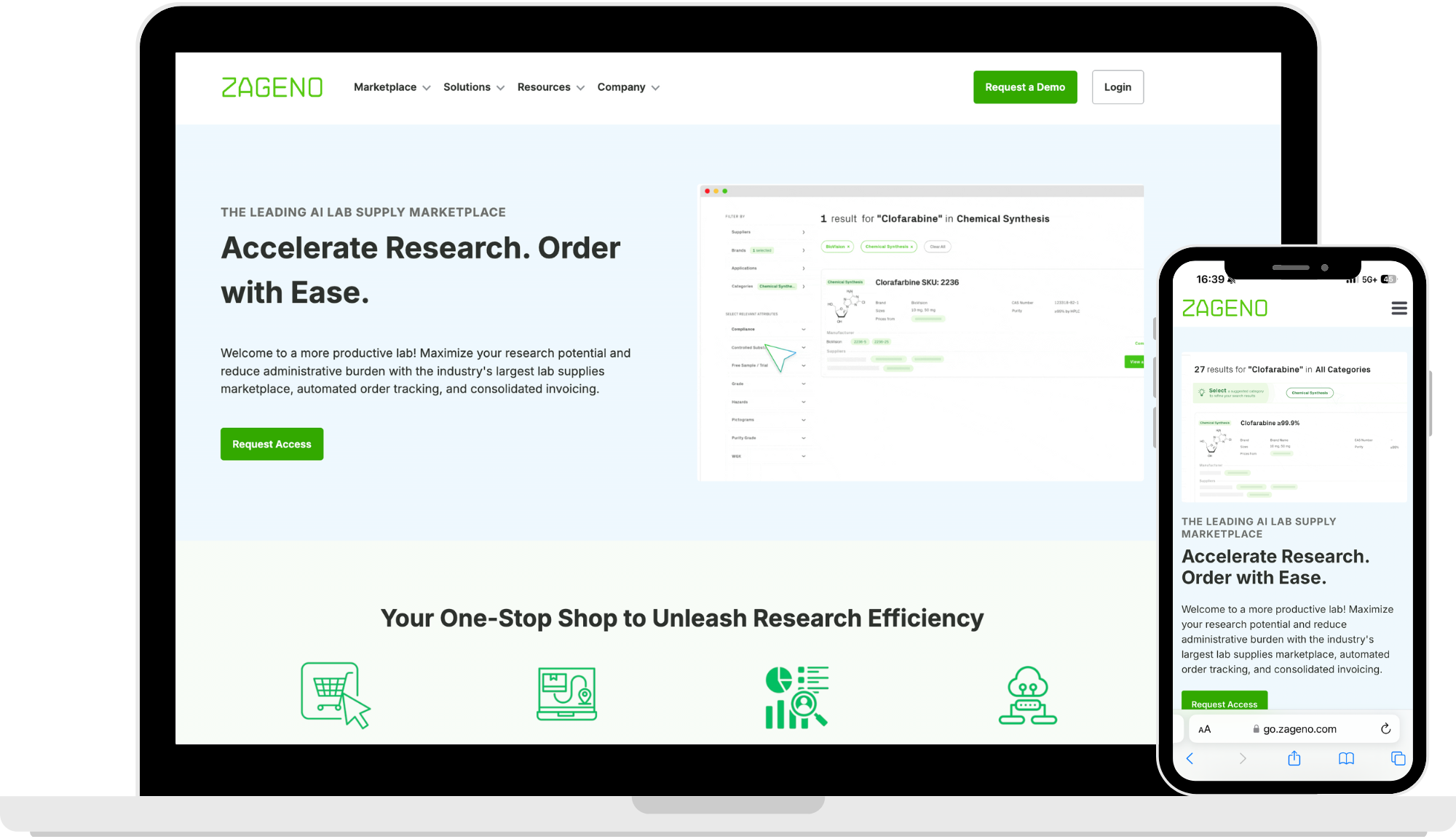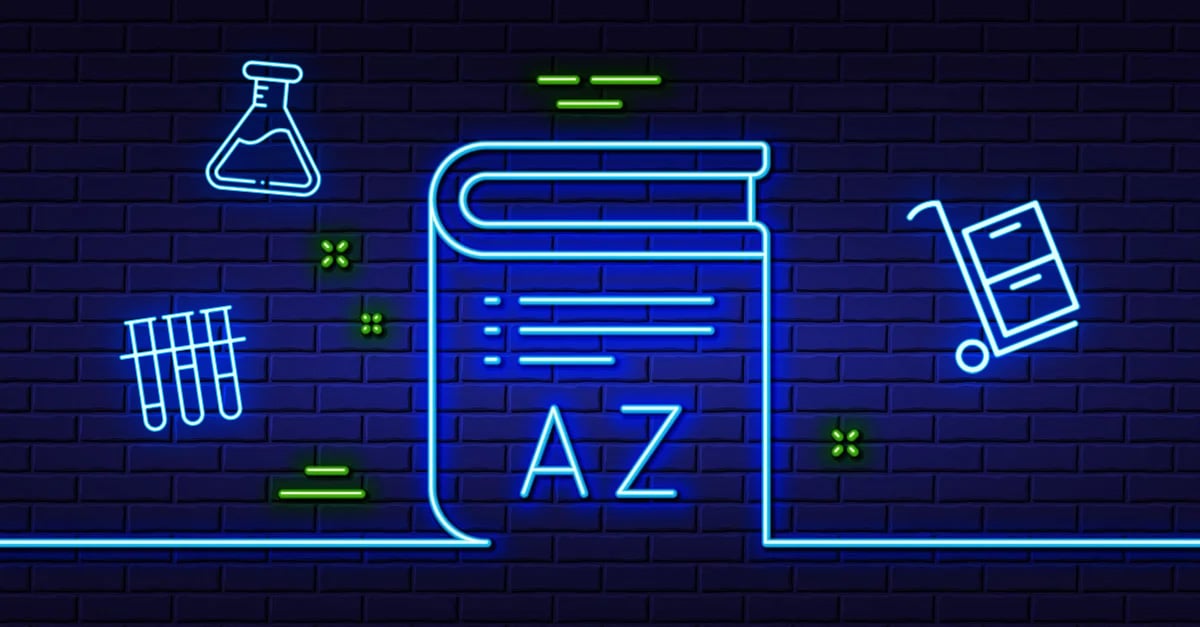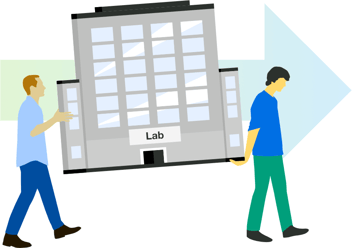“I can’t wait to plan a lab move!” said no one ever. From specialized equipment handling to regulatory compliance, every lab move detail matters, and every delay can cost time, money, and research progress. Whether you’re a scientist, lab manager, or facilities lead, this glossary is your quick-reference guide to the terminology that drives a successful lab relocation.
Each definition includes insights from ZAGENO’s work helping biotech teams streamline life sciences procurement before, during, and after moves. From updating vendors to holding orders and streamlining P2P setup, we’ve seen what works and what trips labs up, so this glossary is backed by real experience reducing downtime, avoiding costly mistakes, and making the transition smoother.
How to use this glossary
- Before your move: Learn the terms so you can plan with precision and communicate clearly with movers, vendors, and contractors.
- During your move: Reference key processes like cold chain management and hazardous materials handling in real time.
- After your move: Understand the protocols for start-up, procurement, and compliance in your new space.
💡
Planning a move? Read our Guide to Avoiding Common Lab Relocation Mistakes
Glossary Table of Contents
Construction and Infrastructure
Lab Relocation Planning and Documentation
Equipment Handling and Maintenance
Lab Inventory Management and Space Planning
Lab Move Logistics and Equipment Transportation
Compliance, Safety, and Laboratory Move Protocols
Construction and Infrastructure
- Accessibility: Facility accommodations for individuals with disabilities, such as wheelchair ramps and accessible restrooms.
- Build-Out Permitting: Required construction permits for compliance with local building codes and regulations.
- Clear Heights: Vertical clearance between floor and ceiling; critical for ventilation, utilities, and moving large equipment.
- Compatibility: Infrastructure’s ability to support specialized lab equipment.
- General Contractors: Professionals managing the build, subcontractors, and adherence to specs.
Lab Relocation Planning and Documentation
- Contingency Planning: Backup strategies for potential delays, equipment damage, or transport issues.
- Data Backup and Recovery: Backing up electronic data and ensuring its secure transfer to the new location, as well as implementing procedures for data recovery in case of unexpected loss or corruption during relocation.
- Documentation: Records like packing lists, inventory logs, and validation reports to track progress.
- Feasibility and Construction Narratives: Building assessments for lab suitability and required modifications.
- Lab Relocation: The process of moving laboratory equipment, instruments, materials, and personnel from one location to another.
- Lab Relocation Specialist: Professionals overseeing every aspect of the move.
- New Site Start-Up: Initiating operations at the new facility, including staffing and procurement setup. Streamline new site start-up by managing lab supply sourcing, vendor setup, and inventory replenishment through a single biotech procurement platform like ZAGENO.
- Risk Assessment: Identifying potential hazards to personnel and equipment.
- Tenant Support and Services: Landlord-provided maintenance, repairs, and support.
- Value Engineering: Cost-effective alternatives for construction.
Environmental Considerations
- Cold Chain Management: The specialized handling and transportation of temperature-sensitive materials, such as biological samples or reagents, to maintain their integrity and viability during relocation.
- Environmental Monitoring: Measuring temperature, humidity, and air quality in the new lab to ensure optimal conditions for sensitive scientific equipment and experiments after relocation.
- Sustainability: Eco-friendly practices like recycling packing materials to reduce waste during the move.
Equipment Handling and Maintenance
- Cryogenic Storage Transfer: Safely moving ultra-low temperature samples to minimize the risk of sample damage or thawing during relocation.
- Fume Hood Decommissioning: Disconnecting and sealing equipment to prevent chemical exposure.
- Installation: Setting up and assembling lab equipment and instruments to manufacturer specifications.
- Instrument Calibration: The adjustment or verification of laboratory instruments to ensure accurate and reliable measurements pre- and post-relocation.
- Lab Move Insurance: Coverage for potential damages or losses incurred during the relocation of laboratory equipment, materials, and supplies, offering financial protection against unforeseen events such as accidents, breakage, or theft during transit or handling.
- Validation: Confirming lab equipment and instrument functionality after relocation.
Lab Inventory Management and Space Planning
- Chemical Inventory Management: Tracking hazardous and controlled substances for compliance with safety regulations and to prevent spills or leaks during relocation.
- Inventory Management: Cataloging lab items to prevent loss or damage.
- Lab Equipment Inventory: Complete record or database documenting all equipment, instruments, and apparatuses present in the lab, as well as a wish list for any new equipment to be incorporated into the new laboratory space.
- Lab Supply Replenishment: Restocking necessary lab supplies post-move. If you’re restocking during or after your move, lab supply marketplaces like ZAGENO allow you to compare product availability and lead times from thousands of suppliers in real-time, helping you avoid delays and duplication.
- Legacy Site Decommissioning: Decontamination and safe closure of the previous lab site.
- Long-lead Equipment: Essential machinery or instruments that require a lengthy procurement process due to factors such as customization, specialized manufacturing, or limited availability, often necessitating early ordering to ensure timely project completion.
- Space Planning: The process of determining the spatial requirements of a laboratory facility, including equipment inventory, room sizes, and quantities, to ensure an efficient and functional layout.
Lab Move Logistics and Equipment Transportation
- Change Orders: Adjustments to construction plans that impact budget and schedule.
- Cold Storage Unit: Refrigerated storage equipment used for preserving temperature-sensitive materials or samples in laboratory settings.
- Customs Clearance: Documentation for international equipment moves.
- Hazardous Materials Moves: Specialized transport for high-risk substances.
- Physical Move Planning and Execution: Scheduling movers, sequencing transport, and protecting sensitive equipment.
- Post-relocation Support: Helping staff adapt to new lab conditions.
- Transportation: The movement of laboratory equipment and materials from the old location to the new location, often involving coordination with transportation companies.
- Specialized Equipment Handling: Moving large or delicate instruments like centrifuges, mass spectrometers, or electron microscopes, using specialized lifting equipment or techniques.
Compliance, Safety, and Laboratory Move Protocols
- Compliance: Meeting safety, environmental, and biosecurity regulations.
- Decontamination: Neutralizing hazardous materials from surfaces and equipment.
- Electrical Safety Inspection: Ensuring electrical systems meet code before powering equipment.
- Hazardous Material Handling: The safe handling, packaging, and transportation of hazardous materials, such as chemicals or radioactive substances, in compliance with regulatory requirements during relocation.
- Regulatory Compliance Verification: The verification of compliance with relevant regulations and guidelines, such as OSHA, EPA, or FDA regulations, in the new laboratory location before resuming operations after relocation.
- Safety and Security Features: The new facility’s inclusion of fire suppression systems, emergency exits, first aid facilities, surveillance cameras, access control systems, and compliance with safety standards and regulations.
- Waste Management Plan: The development of a plan for proper disposal or recycling of laboratory waste, including hazardous materials, packing materials, and obsolete equipment, generated during the relocation process.
Vendor, Supplier, and Landlord Relations
- Biotech Procurement Software: Platform built specifically for life sciences that streamlines ordering, pricing comparisons, and invoicing.
- Contracts and Procurement: Finalizing agreements for construction, equipment, and supplies.
- Landlord Move-Out Requirements: Lease conditions for restoring vacated spaces.
- Lease Negotiations and Execution: Securing favorable terms for the new lab.
- New Vendor Set Up: Establishing relationships with new suppliers. Some lab procurement platforms, like ZAGENO, eliminate the need for manual vendor onboarding and supplier management by giving you instant access to over 5,300 pre-vetted lab suppliers through a single portal.
- Vendor Coordination: Scheduling vendor maintenance, calibration, or installation services before and after relocation to minimize downtime and ensure smooth operations.
Ready to Make Your Lab Move Easier?
Whether you're moving a small research lab or a large pharmaceutical facility, ZAGENO helps streamline lab relocation planning, procurement, and vendor coordination. You may never grow to love planning a lab move, but by letting our platform do the heavy lifting, your team can focus more on the science.

See how ZAGENO supports lab moves
Frequently Asked Questions
A laboratory relocation is the organized process of moving a research or scientific facility to a new location. It typically covers everything from equipment inventory and vendor coordination to transportation, compliance checks, and setting up operations at the new site. Whether you’re moving across the street or across the country, a successful relocation requires strategic planning, specialized expertise, and steps to keep research interruptions to a minimum.
Read more: Moving Your Laboratory Safely, the NIH Office of Research Facilities’ best practices for safe and compliant lab moves.
A lab relocation covers all aspects of transferring a working laboratory to a different facility. This can involve assessing and documenting inventory, safely decommissioning and reinstalling equipment, preparing compliance documentation, managing logistics, and validating equipment after the move to ensure safety and minimal downtime.
Read more: OSHA’s detailed guidance on laboratory safety protocols during a move.
Lab relocation is the physical transfer of laboratory equipment, materials, and personnel to a new space. Lab migration, in contrast, often refers to moving digital assets, such as laboratory information management systems (LIMS) or procurement software, without a physical move of the lab itself.
Effective lab relocation planning starts with a detailed inventory and risk assessment. Next, develop a project timeline, assign responsibilities, and engage a relocation specialist. Coordinate closely with vendors, set contingency plans, address regulatory requirements, and ensure all staff are ready for setup, testing, and validation in the new facility.







